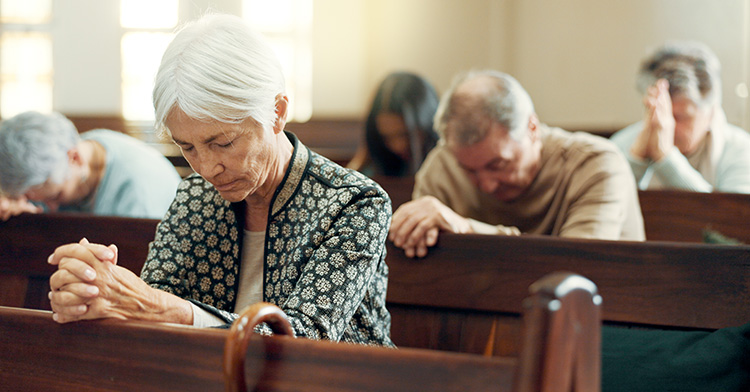To outsiders, the Army may look like a rigid hierarchy in which orders flow down from the top to unthinking subordinates who bow down and obey, says retired Army Lt. Gen. James Dubik.
But that is not the case.
“We have a set of nested leadership responsibilities that are multifunctional and not just a hierarchy,” says Dubik, now a consultant for and board member of the National Leadership Roundtable on Church Management.
“Every commander is also a teacher, so your job as a senior leader is to develop your subordinates,” he said.
Generally, every senior officer is responsible for training people two levels below and, in turn, knowing the mindset of those two levels above. As a result, leaders at every level understand the broader goals and mission beyond their own positions and are thus empowered to act creatively within that understanding.
“This is a coherent set of leaders who as a body are moving the organization forward, moving a mission forward,” Dubik said.
Dubik spent 40 years in the military. In his final command before retiring in 2008, he oversaw the training of Iraqi security forces.
He spoke with Faith & Leadership about the Army’s approach to leadership development. The video clip is an excerpt from the following edited transcript.
Q: How does the Army develop leaders?
Three approaches occur simultaneously: institutional, organizational and personal.
Institutionally, we have a well-structured, transparent and clear approach: select, train and promote.
You select a person for promotion, you train the person before he or she gets promoted, and then you promote the person and put him or her in the job.
This is a progressive set of educational experiences, whether you’re a sergeant or an officer.
Before you’re a sergeant, for example, you go to basic leadership school. When you get your first stripe after sergeant, you go to basic noncommissioned officer school. You get your second stripe; you go to advanced. You get your third stripe, and so on.
This system recognizes that as a person grows in responsibility, as their role and the scope of their job gets larger, the institution has an obligation to prepare that person for the duties that he or she is expected to execute.
The same thing happens with officers -- lieutenants, captains, majors, every one of us. Before you get promoted, you go to a school.
We also have specialty schools for technical specialties and command operations. Before I commanded, for example, at the company level, which is 150 people, I went to a company commander preparation course.
It wasn’t long, a couple of weeks, but it was specifically designed to help me think through the kinds of issues that I would face as a company commander. Again, the same thing at each level.
Although it happens occasionally, we don’t want to put anybody in a job they are not prepared for. So with “select, train and promote,” we do the best we can to prepare them.
Q: And the organizational side of leadership development?
Regarding the organizational approach, every commander is also a teacher, so your job as a senior leader is to develop your subordinates.
Our general rule is you develop subordinates two levels below you. So, for example, if I am a lieutenant colonel -- a commander of a battalion of 500 people -- part of my job is to train my majors, who are one level down, and my subordinate commanders, captains. And the major’s job is to develop captains and the lieutenants two levels down, who are generally entry-level leadership positions.
It’s engrained that we expect our senior commanders to help develop people two levels down, and this occurs in day-to-day operations.
If I’m a lieutenant colonel circulating in the battlefield and I see a captain doing something that captains shouldn’t be doing, my job is to teach that person, “Hey, that’s not really a captain’s job.”
You do that always on the side, always in the right way if at all possible.
It also happens in meetings. Meetings are teaching opportunities, if you use them correctly. It also happens in social events. The commander is expected to have social events to bond the unit, to help develop a sense of camaraderie in an organization.
There are also formal trainings. What the Army does is train. If it’s not a war, it’s training. So training is a way to challenge leaders to develop certain skills.
As a company commander, you analyze which skills people are very good at and which skills they aren’t good at and then set the conditions in your training to help you develop the skills that they are not good at.
Q: And the third approach, the personal?
In the Army, each of us is also responsible for our own development.
The Army expects everyone to read beyond their current position, to do some historical study of people who had similar positions above them, so that the onus is not just on the institution, not just on your commander and your organization; it’s also on you.
We’re responsible for our continued development intellectually and physically. Our profession is a tough profession, so you have to maintain some sense of physical fitness.
Q: Regarding that second approach, the organizational, you’re basically saying that leadership development practices are inherently built into the Army’s organizational structure, its hierarchy. Give us an example of what you’re talking about and how you’ve used this approach in developing leaders.
I’ll use myself in Iraq. Two levels up from me was the secretary of defense and the president. I had to execute what I did in Iraq consistent with their intent.
I didn’t talk to these guys often, but I read a lot of what they wrote. I listened to their speeches and their testimonies so that I would have a sense of the direction they were going.
Two levels below me were a set of colonels who were training the Iraqi army, the police, the navy, developing the ministerial systems and the minister of defense.
They had to understand the direction I wanted to go so that in their day-to-day activities they could use their initiative and creativity in a way that was consistent with the overall direction.
The hierarchy is not just so that orders can flow down and subordinates can bow down. This is a coherent set of leaders who as a body are moving the organization forward, moving a mission forward. The set of leaders are also psychologically tied. In battle, things don’t always go well, and when a subordinate knows that he or she is tied up and down in a nested set of people who care for them, then the difficulties of battle start to be bearable.
Externally, the chain of command looks like a hierarchy where the general at the top says, “Everyone must X today,” and the order goes all the way down to thousands of soldiers Xing all over the place. But that’s not the case at all; we have a set of nested leadership responsibilities that are multifunctional and not just a hierarchy.
Q: So if I’m a lieutenant, it’s not enough that I know what I’m supposed to do as a lieutenant. I’m supposed to know also what the captain is thinking. I’m supposed to know what the major is thinking.
Right. Exactly.
Q: And the beauty of this becomes that I’m not trapped in my lieutenant role. By knowing the thinking of those one and two levels up, it frees me up and actually makes for a decentralized command.
The challenge in our profession is to understand that in war you must accomplish two things.
You must allow your subordinates maximum flexibility, because opportunities and challenges arise at the point of battle that cannot be foreseen.
If the subordinate waits to report up and wait for instructions, the opportunity will have gone away and the challenge will only have grown. So you want decisions to be made at the lowest possible level.
The other side of the coin, though, is that a subordinate can desynchronize a large operation by acting in an errant way, in a way inconsistent with the overall direction of the organization.
You have these dueling challenges as a commander: use your creativity, but don’t screw the big plan up.
The way that we tried to balance those two seemingly opposite realities is what we call “commander’s intent,” so that I explain my intent such that people two levels below know what I want to accomplish.
What’s the purpose of this operation? What effect are we trying to have on the enemy? What are the parameters in which I am to operate, the things that I can and cannot do? What are the things that I must do?
That creates a dynamic where the subordinate can use his or her creativity within that intent. It increases the probability that the subordinate will act and decide quickly to take advantage of opportunities and overcome obstacles before they become large, without desynchronizing the larger operation.
That’s the dynamic you want to set up. When you have this “commander’s intent” nested properly up and down the chain of command, you increase the probability of success astronomically.
The onus, though, is on the senior commander. If I’m a colonel, I can’t assume that my lieutenant colonels and captains know my intent or how to act within it.
Part of the training and leader development that occurs is about building an understanding of that intent. I help them. I set up training exercises where they’re not in communication so they must decide and act within my intent, and then we have a discussion afterwards about what went well and what didn’t go well and why did you make that decision -- that wasn’t my intent.
That helps establish the nested understanding that you need.
Q: In the giving of orders, the exercise of command, how much authority comes from the rank and how much from the person who’s in the position?
They’re equal.
We’re a deferential hierarchy, so there is deference and respect to the rank. But we’re also an organization of human beings, and it’s probably not surprising that some people wear their rank better than others. It’s the combination, in the final analysis, that works.
Look, American soldiers are really great Americans, but they’re still Americans, and Americans are really good at not doing something they think is really stupid.
So if an American soldier gets an incredibly stupid order, they’re going to say, “Yes, sir. Roger that,” and then it will never happen. Because something happened -- we couldn’t get this; we couldn’t get that. Some legitimate reason will pop up.
The fact that you issue an order as a senior officer is interesting, and may be compelling, if the order makes sense.
There is this positional authority that exists at every rank, and the higher you go, the more your position is respected -- but less important.
As a three-star in Iraq, I reported to General [David] Petraeus and the secretary of defense above him and had working for me 13 general officers and flag officers of a variety of nations, each of whom was a seasoned professional with more than 30 years’ experience.
So you lead that group in an entirely different way -- a much more participative, collegial, discursive leadership style -- than you might in the situation where you have a battalion commander with 24 years’ experience over people with five and less.
As you grow in rank and responsibility, the type of leadership -- the way you get people to align around the common goal of the organization and move forward -- changes and becomes much less positional and much more personal.
Q: Lieutenants are in the unusual position of commanding people, especially sergeants, who have far more seniority than they do, which is in some ways similar to the situation young pastors often find themselves in. How do you teach leadership in that situation?
A lieutenant is in charge of 20 to 40 people and has subordinate leaders who are sergeants. There are no other officers in the lieutenant’s organization. So a 21-year-old lieutenant finds himself responsible for a set of sergeants who are far more experienced.
When I was a first lieutenant in the 82nd Airborne Division, my platoon sergeant had four tours in Vietnam and two of my squad leaders had tours in Vietnam. I did not. I came right out of Gannon College with my philosophy degree and my paratrooper wings and showed up as their leader.
So the first thing that a lieutenant has to understand is that you don’t have to know everything and you don’t have to make every decision yourself. Generally, it’s the platoon sergeant who teaches the lieutenant this. I know my platoon sergeant taught me.
When I issued an instruction that would be not so good -- which I did as a lieutenant; all lieutenants do -- he would pull me off to the side and say, “Lieutenant, that really wasn’t the right thing to say. You ought to go back and change it this way.”
He would then create the conditions that if I did as he suggested, he would tell the sergeants, “See, this guy is smart. We can teach him. He can learn. He’ll be good.”
Whereas if a lieutenant just gives him the stiff-arm -- “I’m the officer here; you’re not. Just do what I say” -- it sets up a really bad dynamic.
Generally, the lieutenant learns one way or the other, either through positive reinforcement or negative reinforcement. But the better lieutenants are the ones who listen and understand that it’s OK to learn from others.
When a sergeant comes to the lieutenant and says, “Here’s my experience; here’s what I think we ought to do,” the sergeant isn’t stealing authority from the lieutenant.
It’s not like you have this bag of authority and someone cut a hole in it and is draining it.
This is a person who is trying to increase your authority by teaching you as a lieutenant that it’s not the bar on your shoulder but it’s this other aspect of leadership -- your proficiency, your ability to make sense, to listen, to adapt and learn. So sergeants play a very critical role in leadership training of officers.
Q: I wonder who the “sergeants” are in congregations or in denominations who can help play this role for young pastors starting out.
I wouldn’t want to overstretch the analogy, but the issue lieutenants face is responsibility for an organization under conditions where that person doesn’t understand how the organization runs yet completely, nor does he or she have full understanding of the people in that organization.
So the real issue for me becomes a learning issue.
Am I so arrogant that I’m not going to learn from other people, even from my subordinates? Am I so arrogant that even though I know what I don’t know, I’m not going to go find a person that does know and then use their knowledge?
If that’s the kind of person I am, leadership is not going to be easy for me, and followership will go down, not up.
There’s a contract between leaders, an implicit contract, where I acknowledge you as a leader. I will follow you as a leader and you will take care of me in the process. You will make the best decisions with the best set of information available as possible. There’s this mutuality.
When I took over my first platoon -- no, my second platoon -- I went in and I took over in an official ceremony and went to meet my sergeants. And one guy, Sgt. Mark Archer, was sitting in the back at a corner, and he was like, “Hmm,” and I went up to him afterwards.
I said, “Mark” --- or, “Sgt. Archer, what’s the problem?” I know him as Mark now, because we’re still friends. This was from 1974. So, “Sgt. Archer, what’s the problem?”
He says, “Well, I’m just looking at you and making up my mind whether I’m going to risk my life for you.”
Well, that kind of puts a sharp point on it right then and there, and it’s that kind of expectation that followers have of their leaders.
“I’ll follow you, buddy. But I want to follow you more out of interest. I want to follow you because I have some confidence in your ability.”













